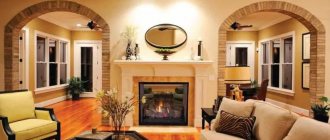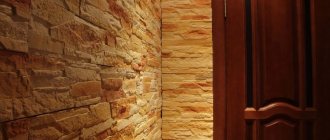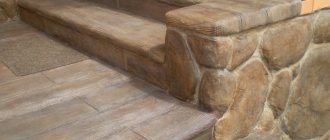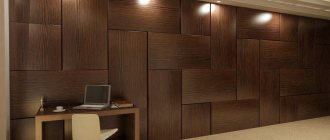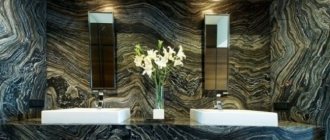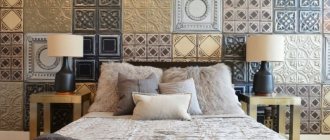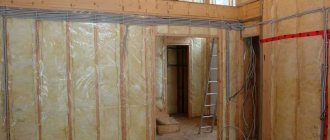The arrangement of any house or apartment involves a number of sequential works. But it’s what the walls are decorated with that usually determines how cozy and comfortable it will be for you to spend time in it. This means that the choice of material must be approached very carefully. A very popular option today is decorative stone wall decoration. Whether it is possible to implement such an idea specifically for your home and how much it will cost you in terms of financial investments, you can understand by reading this article.
Advantages of decorative stone wall decoration
There are many varieties of decorative stone of natural and artificial origin that can be used for interior decoration.
Each of them has its own characteristics, but several advantages can be identified that are characteristic of all types of decorative stone - these are:
- Durability that results in a long service life.
- Wide color and texture palette, which provides endless design possibilities.
- Regulating indoor air quality naturally.
- Preservation of the shade of the stone throughout the entire period of operation - even with direct exposure to sunlight, fading does not occur.
- Environmentally friendly - even artificial stone, subject to technological standards, includes only natural, harmless components in its composition.
- Fire safety - no type of stone is subject to burning or melting.
- Pleasant texture for tactile perception.
- The ability to perform a full cycle of work (stone production and installation) with your own hands, without the involvement of qualified craftsmen - this will significantly affect the cost items.
Important! The weight of the parts, as well as the price of finishing the walls with decorative stone, will vary. These factors will influence your decision in choosing a specific type of stone. Be sure to take them into account, since heavy stones are not always suitable for decorating walls with a small load-bearing load, and insufficient funds can lead to a slowdown or interruption of the installation process, which will also be unpleasant for you.
Surface preparation
Before applying decorative plaster, the wall needs to be prepared. The surface must be completely cleaned of various coatings and made smooth. Although, no one demands perfect smoothness from you. Be sure to remove all salt bulges and grease stains. Only after this can the wall be primed. This is necessary to improve the contact of decorative plaster with the wall. By skipping this step, you risk getting an unreliable final coating.
In nature, masonry is made up of different sized stones. We will consider the option of laying on a flat surface, without bulges. Stones, just like in natural masonry, will have a variety of sizes. For this we only need imagination, a wallpaper knife and masking tape.
The primed wall must be covered with strips of masking tape. Thereby defining the seams between the stones. Cover the entire wall at once, even if the area of the room is very large and the decorative plaster is planned to be applied in certain portions.
Using this method you can create an imitation of brickwork. Simply tape the wall parallel to the floor with strips of tape to create straight horizontal lines. And then, using masking tape, make future vertical seams. This way you get a lot of small bricks, as if it were real brickwork.
Room design with stone
Decorating a hallway or room with decorative stone with your own hands opens up unlimited design possibilities. You can stick to template ideas or think through your own unique project - it all depends on your capabilities and talents.
Take note of a few interesting ideas that you will definitely find application in the design of your home:
- Consider the design of a room with stone only if it is bright and spacious. If this is not possible, give preference to a combined cladding of stone and plaster, light-colored wallpaper or paint.
- Consider the possibility of additional illumination of areas with decorative stone - this will help create a more interesting decorative effect and make it sophisticated. LED lamps located anywhere in the room are perfect for this purpose - below the walls, above them, on opposite walls.
- Feel free to use decorative stone to decorate columns, arches, fireplaces, window and door openings, areas with a fountain or an aquarium - here it will look very appropriate and organic. The same rule applies to green areas with climbing or large plants.
- To decorate the walls with decorative stone in the hallway, focus on its spaciousness. The less space, the less massive the stone should be. Also, in such a situation, it is worth abandoning the complete covering of the entire surface in favor of decorating exclusively the corners, the lower or upper part of the walls. A very interesting option is to create a small panel from stones of different types.
Important! To avoid possible technical errors and not to spoil the supposedly beautiful picture of your decor, consider the following recommendations from the experts:
- Do not make the seams too wide, otherwise the torn stones will not look very aesthetically pleasing.
- Prime the base well, do not skimp on the solution and do not rush to complete the process before it is completely dry. This will ensure good adhesion of the parts to the surface, which means that after a short time the stones will not fall off.
- Carefully select the combination of elements and their order in color and size. They must be in perfect harmony with each other.
- Carefully observe the rows of laying so that the picture of the overall canvas is not beveled or chaotic.
Preparatory stage
- remove old finishing material;
- carefully scrape off all the scraps that, one way or another, may interfere with you in the future;
- inspect the wall for cracks and irregularities;
- if you notice cracks, then use a hammer and chisel to make them a little wider and fill the holes with a deep penetration primer - this will help prevent the appearance of always unwanted mold;
- carry out the initial treatment of the wall surface with a primer - it is not necessary to achieve a perfectly smooth surface, since after puttying the priming procedure will have to be repeated;
- if the surface is very uneven and there are noticeable defects, then go over the wall with plaster, and also cover the cracks previously treated with primer;
- to achieve a perfectly smooth wall after plastering, it makes sense to use gypsum-based putty - it is not so rough in consistency and will help make the wall flawless, eliminating those irregularities that plaster, for objective reasons, cannot cope with;
- the final touch is re-priming the surface, this time we are pursuing the goal of achieving excellent adhesion to the decorative material that will be used to imitate brick, the treatment must be carried out carefully, generously lubricating those areas that very quickly absorb the solution.
Popular articles DIY paper box. step-by-step instructions + 800 photos
How to check if your wall is ready for the next stage? Everything is very simple: run your hand over it - if you don’t feel any obstacles or unpleasant roughness, it means you have successfully completed such a tedious, but still necessary preparatory stage.
Types of natural stone
Natural stone has been used in construction and facing work since ancient times. It gives a special flavor and solidity to the interior, but in most cases it will be quite expensive. To implement your project, you can select elements from the following rocks.
Granite or quartzite
These are the 2 most dense, hard multicomponent rocks. They are ideal for long-term finishing of any indoor space, and are also used for external cladding. Both stones have almost zero water absorption and do not get dirty at all. They have a wide range of tint palettes of red, blue, orange, grey, pink, green. This means they are excellent for finishing in any operating conditions.
Important! By choosing this option, you will have to spend a minimum of effort on caring for the finished coating.
Marble
Marble is used by individuals with refined taste. Walls with such cladding will not only be durable and practical, but will also emphasize the solidity, exclusivity and nobility of the interior. Marble will fit perfectly into both classic and any modern style.
Important! In terms of its technical characteristics, marble is almost as good as granite, but has a more attractive variegated color. From this rock you can easily create parts of any shape with a matte or polished surface, as it lends itself well to processing.
Travertine
Travertine is another very popular stone for wall decoration. In addition to strength acceptable for interior finishing work, it has excellent thermal conductivity. It is for this reason that it is a more advantageous option when compared with cold marble and granite.
Depending on what natural factors contributed to the formation of this stone, it may be available for sale with a porous or relatively dense structure. But thanks to its pliability, it can, if necessary, be processed, polished, and it is even possible to create 3D canvases from travertine.
Important! The standard color palette includes very cozy shades of several options:
- red;
- white;
- brown;
- nut;
- yellow;
- beige.
Limestone
Limestone is often used for wall cladding not only because of its low thermal conductivity, optimal strength and durability. Many are impressed by its pleasant appearance, very low price and natural antibacterial properties.
Important! When choosing the right color, you can count on shades of yellow, green, brown, red and white in varying degrees of saturation. The only nuance that is extremely important to know is that this rock exfoliates and crumbles over time.
Onyx
One of the most beautiful decorative stones for decorating walls in the house is onyx. It looks especially advantageous when decorated with proper lighting. By choosing this type of rock as the main element for wall decor, you don’t have to worry about service life - the strength and moisture resistance of onyx will ensure its durability.
Important! As for design possibilities, the layered structure of this stone can include elements of blue, red, white, and gray.
Slate
Slate is one of the heaviest and most expensive stones. But it belongs to the category of luxury finishing due to its unique properties.
Important! Gray, burgundy, bright green, blue, red, yellow or graphite-black stone will be appropriate and look very organic in the interior in the following styles:
- high tech;
- brutalism;
- loft;
- minimalism;
- classic.
Sandstone
This stone contains components of sedimentary origin - quartzite, carbonate, iron ore. It is this combination that determines the high strength of this rock, which can be equated to the strength of granite.
Sandstone with both a layered and fine-grained structure looks very interesting in the interior. And the color palette opens up wonderful possibilities for imagination - red, beige, brown, grey, blue, white. You can use this decorative stone to decorate the walls of even the most daring decisions or for cladding only corners, fireplaces or columns.
Important! Another advantage of sandstone is its inexpensive cost.
Methods of jointing and invoicing
After drying, cement plaster becomes granular and finely porous, which is not entirely natural for most types of rocks. Removing texture and applying jointing is the most creative and delicate part of the finishing process, which determines the believability of the appearance.
It is required that the surface acquires some semblance of a glossy film, which is possible by squeezing a small portion of dissolved cement onto the surface. The best way to achieve this effect is to spray the freshly applied solution with a small portion of water and cover the surface with a film about 10–15 microns thick. The film is laid on the surface and rolled with force with a hard roller, without smoothing out the folds. At the same time, through the transparent shell it is clearly visible how laitance accumulates on the surface.
Popular articles from Mobile “Butterflies”
Types of artificial stone
The main difference between artificial stone is its much more affordable price. In addition, you can make it yourself by designing parts that are unique in shape, color and size. From a technical point of view, decorative stone wall finishing is not much inferior to natural wood cladding:
- Their strength is quite sufficient for arranging the interior walls of a house.
- The weight of many models is much cheaper than natural wood, which also simplifies the installation technology.
- Absolutely any color scheme can be executed, and texture and texture are also easy to choose.
Important! In some cases, not every specialist is able to distinguish a natural stone from a skillful imitation. You can see this for yourself by looking at what the wall decoration with decorative stone looks like in the photo.
Cement stone
Cement artificial decorative stone is made on the basis of sand, cement, reinforcing filler, additional plasticizers and dyes, auxiliary fillers - pumice, expanded clay or ceramic chips.
Important! Cement stone is quite cheap, and it can be used on any surface.
Porcelain tiles
Porcelain stoneware is made from spar, clay, minerals and pigment dyes. Thanks to this composition, it has very high strength and resistance to moisture, high/low temperatures. This is the ideal prerequisite for cladding interior walls.
Important! The only thing that needs to be taken into account when choosing such a stone is that it is presented on sale mainly in the form of tiles, which have significant weight.
Acrylic artificial stone
Decorative stone based on acrylic has become widespread in the last few years. It is widely used for cladding any rooms in the house, regardless of operating conditions.
Its main advantages are:
- inertness to moisture;
- no deformation even after a long service life;
- resistance to chemical and mechanical stress;
- There is practically no contamination of the surface, and if minor stains or deposits form, they can be easily removed with minimal effort;
- light weight and flexibility during processing;
- component composition safe for humans;
- heat resistance.
Important! Acrylic stone is available for sale in a wide range of colors.
Polymer agglomerate
This option is based on quartz chips and polymer fillers. The unique casting and molding technology ensures its outwardly solid design, similar to natural quartz, reliability and resistance to any negative impact.
Important! The product range of all manufacturers is usually limited to only a certain range of colors, but they are quite enough to choose the finishing option that suits you. The only caveat is that monolithic and heavy slabs are not always convenient to fix to walls.
Gypsum decorative stone
Gypsum stone is perhaps the most popular option for wall cladding. Its advantages are:
- minimum weight when compared with all other types of artificial and natural stone;
- property of natural moisture circulation - the microclimate in the room will be regulated naturally;
- sufficient strength for cladding walls inside the house;
- wide design possibilities;
- good strength;
- fire safety.
Important! This stone is one of those that you can make with your own hands. For this:
- Mix dry plaster with cold water in a ratio of 0.7 kg per 1 liter.
- Mix the mixture thoroughly with a construction mixer.
- Pour into silicone molds.
- Wait until completely cured.
Gypsum decorative stone will cost less than any other.
Other ways to imitate brickwork
False bricks can be obtained by extruding them from flat ceiling tiles made of polystyrene foam without a pattern.
For false bricks, flat polystyrene foam tiles without a pattern are suitable. For our purposes, you can use any of its sides. The optimal size of the “stone” is 7/15 cm. If you increase the proportions, the wall will look unnatural. The process of making “stones” is simple: we squeeze them out of the ceiling tiles.
First, using a gel pen, apply markings to the polystyrene foam. Please note that to maintain the correct shape you need to make seam allowances. Next, take a toothpick and, tilting it, press straight lines along the ruler with slight pressure. Then you need to make a special device: a crusher. To do this, use metal scissors to cut out a flat tin strip from the lid of a tin can, and cut off both sides from one edge of it so that you get a “sting” 2 mm wide. Using this device we press our bricks along the lines in the ceiling tiles.
We glue the finished products with our own hands onto the desired part of the wall. We use ceramic tile adhesive as a binder. There is no need to fill the seams with plaster. The gaps between the “stones” need to be made very small: 1-1.5 mm. After finishing the gluing work, the bricks need to be painted. We try to apply as much paint as possible into the gaps, thereby creating an imitation of brickwork.
Popular articles Polymer clay pancakes
wooden bricks
Using imitation brickwork, you can achieve the maximum decorative effect with a minimum thickness of the coating.
This method is quite simple: with our own hands we make the required number of wooden dies of the same size and rectangular shape. If you sand them on one side, you get a stylish, beautiful wall surface with an imitation of brickwork. Work on installing the “stones” begins with markings. Along this horizontal line, starting from opposite corners of the wall, we install the bricks, keeping an equal distance between them corresponding to the selected seam thickness.
First, we lightly nail the wooden dies to the wall with thin nails. When the entire row is laid out, we will drown them in plaster. When all the rows are completed, we will cover the ends of the brickwork with wooden slats. Then we paint the wood with our own hands in the desired color. It is recommended to make the seams much darker. Over time, the wall can be refreshed by repainting it or covering it with wood varnish. This imitation brick wall is very durable.
tile adhesive bricks
For the manufacture of parts, any tile adhesive is used, which is sold in the form of a dry mixture. It needs to be diluted with water until it becomes a very thick sour cream. It is best to use a white composition. Then we divide the whole mass into 3 parts, adding a little paint to each of them.
It is important that the paint differs in shade in each part
Mix the mass in each pile like dough. We will get a mass with beautiful stains. Roll it out into a “pancake” and cut bricks of the same size. We lay them out to dry. We do this until we collect the required number of “stones”. We glue it to the wall using the same tile adhesive. Fill the seams with a compound painted in a darker color. At the end, the wall surface can be covered with several layers of varnish.
Pasting
Laying tiles begins from the corner.
Before installation, the back of the tile must be inspected. If there is a white coating, remove it with a stiff bristle brush.
If the apartment is hot or humid, the back side of the stone is moistened with water. Then a layer of glue is applied.
The fragment is pressed against the surface of the wall, achieving the desired position. By moving it slightly from side to side, they achieve tight contact with the wall and position the fragment in the desired position.
When working with tiles, adhesive may get onto the surface. It needs to be removed immediately.
Stone surface imitation technology
Imitation of masonry on a plastered surface is carried out in several ways:
The “Wild Stone” technology involves applying a base to a small amount of surface, then covering it with a finishing coating and imitating a stone surface using a trowel.
After drying, color streaks are applied and rubbed into the surface with a sponge.
The Marmorino technology is based on knocking out rectangular stone boundaries using a chisel on a previously applied and completely dried layer of a special plaster mixture.
The formation of the “Ragged Stone” pattern is carried out in a similar way, only the notches are made not along straight lines, but chaotically.
Applying a relief pattern using special forms that replicate the structure of natural stone.
This form is applied with a little force to the previously applied and not yet set plaster mixture and the profile is squeezed out.
The molds are made from plastic. polyurethane or polymer. They can be in the form of brickwork. natural stones of different sizes and others.
Stone plaster has a wide range of uses. It is used for:
- External cladding of building facades;
- Coverings of basements and foundations;
- Column finishing;
- Decorative design of fences;
- Finishing of interior walls of premises, both completely and in fragments in the form of panels;
- For cladding arches, openings, fireplaces, bar counters and other elements of interior decor.
